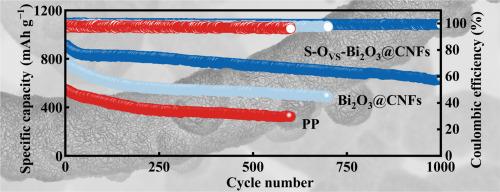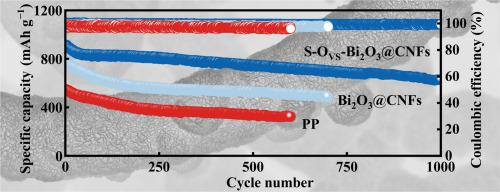Schottky-type oxygen defect and orbital engineering of bismuth oxide for boosting sulfur redox kinetics
IF 20.2
1区 材料科学
Q1 CHEMISTRY, PHYSICAL
引用次数: 0
Abstract
Lithium-sulfur (Li||S) batteries face significant challenges due to the shuttle effect and sluggish redox kinetics of lithium polysulfides (LiPSs). In this work, Schottky-type oxygen vacancies-enriched p-block bismuth oxide (S-OVS-Bi2O3) is integrated onto lignin-derived carbon nanofibers (CNFs), forming a functional layer (S-OVS-Bi2O3@CNFs) on the separator of high-performance Li||S batteries. Schottky-type oxygen vacancies induce localized crystal lattice distortions, which in turn alter the spatial distribution of the local electronic density, modify the band structures of S-OVS-Bi2O3, narrow the band gap, and enhance electronic conductivity by promoting interband electron transfer. In situ characterizations confirm that S-OVS-Bi2O3 effectively mitigates the shuttle effect and facilitates the redox reactions of LiPSs. The S-Ovs-Bi2O3@CNFs-based cells exhibit a cyclability of 630 mAh g−1 at 1 C over 1000 cycles with a degradation rate of 0.032 % per cycle, and a high areal capacity of 4.36 mAh cm−2 under a high sulfur loading of 7.0 mg cm−2. This work highlights the influence of Schottky-type-vacancy-induced modulation of the p-orbital electronic configuration and p-band center, which lowers antibonding energy, improves electron occupancy in antibonding orbitals, and optimizes the chemical adsorption for LiPSs, offering valuable insights for the design of future electrocatalysts in energy storage applications.


肖特基型氧缺陷和促进硫氧化还原动力学的氧化铋轨道工程
锂硫(Li b| |S)电池由于多硫化物锂(LiPSs)的穿梭效应和缓慢的氧化还原动力学而面临重大挑战。在这项工作中,将schottky型富氧空位p块氧化铋(S- ovs - bi2o3)集成到木质素衍生的碳纳米纤维(CNFs)上,在高性能Li||S电池的分离器上形成功能层(S-OVS-Bi2O3@CNFs)。肖特基型氧空位引起局域晶格畸变,从而改变了S-OVS-Bi2O3的局域电子密度的空间分布,改变了S-OVS-Bi2O3的能带结构,缩小了带隙,并通过促进带间电子转移提高了电子导电性。原位表征证实,S-OVS-Bi2O3有效地减轻了穿梭效应,促进了LiPSs的氧化还原反应。S-Ovs-Bi2O3@CNFs-based电池在1℃条件下具有630 mAh g−1的可循环性,每循环降解率为0.032%,在7.0 mg cm−2的高硫负荷下具有4.36 mAh cm−2的高面积容量。这项工作强调了肖特基型空位诱导的p轨道电子构型和p带中心调制的影响,它降低了反键能,提高了反键轨道上的电子占位,并优化了LiPSs的化学吸附,为未来储能应用中电催化剂的设计提供了有价值的见解。
本文章由计算机程序翻译,如有差异,请以英文原文为准。
求助全文
约1分钟内获得全文
求助全文
来源期刊

Energy Storage Materials
Materials Science-General Materials Science
CiteScore
33.00
自引率
5.90%
发文量
652
审稿时长
27 days
期刊介绍:
Energy Storage Materials is a global interdisciplinary journal dedicated to sharing scientific and technological advancements in materials and devices for advanced energy storage and related energy conversion, such as in metal-O2 batteries. The journal features comprehensive research articles, including full papers and short communications, as well as authoritative feature articles and reviews by leading experts in the field.
Energy Storage Materials covers a wide range of topics, including the synthesis, fabrication, structure, properties, performance, and technological applications of energy storage materials. Additionally, the journal explores strategies, policies, and developments in the field of energy storage materials and devices for sustainable energy.
Published papers are selected based on their scientific and technological significance, their ability to provide valuable new knowledge, and their relevance to the international research community.
 求助内容:
求助内容: 应助结果提醒方式:
应助结果提醒方式:


